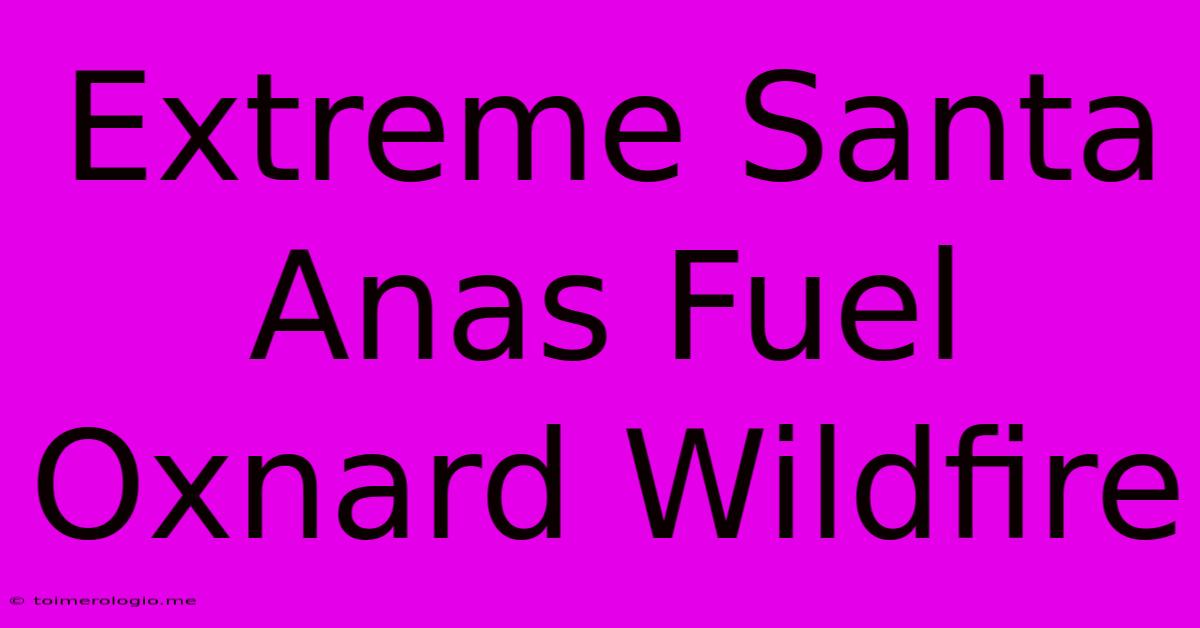Extreme Santa Anas Fuel Oxnard Wildfire

Discover more detailed and exciting information on our website. Click the link below to start your adventure: Visit Best Website toimerologio.me. Don't miss out!
Table of Contents
Extreme Santa Ana Winds Fuel Oxnard Wildfire: A Devastating Combination
The relentless Santa Ana winds, notorious for their dry, hot gusts, whipped through Southern California in [Insert Date of Wildfire], igniting a devastating wildfire in Oxnard. This event serves as a stark reminder of the volatile combination of extreme weather conditions and the inherent wildfire risks in the region. Understanding the dynamics of Santa Ana winds and their devastating impact on Oxnard, along with the broader implications for wildfire preparedness and mitigation, is crucial.
Understanding the Santa Ana Winds
Santa Ana winds are a naturally occurring meteorological phenomenon, but their intensity and duration are significantly influenced by climate change. These powerful, offshore winds originate in the Great Basin and high-pressure systems over the deserts of Nevada and Utah. As air descends from these high elevations, it compresses and heats adiabatically, becoming dry and significantly increasing its speed as it funnels through mountain canyons and passes towards the coast. This creates a powerful downdraft, often reaching speeds exceeding 60 miles per hour.
The Perfect Storm: Santa Anas and Wildfire Fuel
The key danger of Santa Ana winds lies in their ability to rapidly spread wildfires. Several factors contribute to this:
- Extreme dryness: The air is extremely dry, lowering humidity levels drastically. This creates exceptionally flammable conditions, readily igniting and rapidly spreading any existing fire.
- High wind speeds: The strong winds act as a bellows, fanning flames and spreading embers over vast distances, quickly jumping firebreaks and creating unpredictable fire behavior.
- Fuel availability: Southern California's chaparral vegetation, characterized by dense, dry shrubs and trees, provides ample fuel for wildfires. This vegetation is particularly susceptible to ignition and rapid combustion during Santa Ana events.
The Oxnard Wildfire: A Case Study in Destructive Power
The [Insert Name of Wildfire, if applicable] wildfire in Oxnard, fueled by extreme Santa Ana winds, demonstrated the devastating consequences of this volatile combination. [Insert details about the wildfire: date, time, cause (if known), acres burned, structures damaged or destroyed, injuries or fatalities, evacuation efforts, etc.]. The rapid spread of the fire overwhelmed firefighting efforts, highlighting the challenges posed by these powerful winds. The intensity of the Santa Anas created extreme fire behavior, including:
- Rapid Rate of Spread: The fire consumed vast areas in a short period, outpacing suppression efforts.
- Spot Fires: Embers carried by the wind ignited spot fires ahead of the main fire front, creating multiple fire lines and complicating containment strategies.
- Extreme Fire Intensity: The combination of high winds and dry fuels resulted in extremely intense flames, making direct firefighting extremely hazardous.
Impact on the Community
The Oxnard wildfire had a profound impact on the community. [Insert details about the impact on residents: displacement, loss of homes and businesses, emotional toll, disruption to daily life, etc.]. The event underscored the importance of community preparedness and the need for effective emergency response planning.
Climate Change and Santa Ana Winds: A Growing Threat
Scientific evidence strongly suggests that climate change is exacerbating the intensity and frequency of Santa Ana winds. Rising temperatures lead to increased atmospheric pressure differences, contributing to stronger wind speeds. Furthermore, prolonged periods of drought, also linked to climate change, increase the fuel load and enhance the flammability of vegetation. This creates a dangerous feedback loop, where climate change intensifies Santa Ana winds, increasing wildfire risk, and wildfires, in turn, release greenhouse gases, further accelerating climate change.
Mitigation and Preparedness Strategies
Addressing the growing threat of Santa Ana wind-driven wildfires requires a multi-pronged approach focusing on mitigation and preparedness:
Mitigation Strategies:
- Fuel Management: Implementing proactive fuel reduction measures, such as controlled burns and vegetation thinning, to reduce the amount of flammable material available.
- Building Codes: Enforcing stricter building codes that incorporate fire-resistant materials and construction techniques.
- Improved Infrastructure: Investing in improved infrastructure, such as firebreaks and access roads, to enhance firefighting capabilities.
Preparedness Strategies:
- Community Education: Educating the public about wildfire risks, evacuation procedures, and home hardening techniques.
- Early Warning Systems: Implementing robust early warning systems to provide timely alerts and evacuation notices.
- Emergency Response Planning: Developing comprehensive emergency response plans that address the unique challenges posed by Santa Ana wind-driven wildfires.
Conclusion: Learning from the Oxnard Wildfire
The Oxnard wildfire serves as a stark reminder of the devastating power of Santa Ana winds and the urgent need for proactive measures to mitigate wildfire risk. By understanding the dynamics of these winds, investing in proactive mitigation strategies, and strengthening community preparedness efforts, we can work towards minimizing the impact of future wildfires and protecting lives and property. The ongoing threat of climate change further underscores the importance of a comprehensive and long-term approach to wildfire management in Southern California and beyond. Continuous research, technological advancements, and community engagement are crucial in navigating this ever-evolving challenge. The Oxnard fire is not just a local tragedy; it’s a critical case study highlighting the need for a global shift towards sustainable land management and climate change mitigation strategies.

Thank you for visiting our website wich cover about Extreme Santa Anas Fuel Oxnard Wildfire. We hope the information provided has been useful to you. Feel free to contact us if you have any questions or need further assistance. See you next time and dont miss to bookmark.
Also read the following articles
| Article Title | Date |
|---|---|
| Premier League Clubs Psr Charge Escape | Jan 15, 2025 |
| Oxnard Wildfire Update Santa Ana Winds | Jan 15, 2025 |
| Ventura County Wildfire Spreads To 56 Acres | Jan 15, 2025 |
| 2 2 Draw Brentford Battles City | Jan 15, 2025 |
| Brentford Vs Man City Live Soccer | Jan 15, 2025 |
